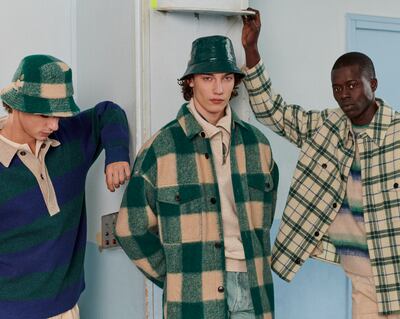
The Business of Fashion
Agenda-setting intelligence, analysis and advice for the global fashion community.

Agenda-setting intelligence, analysis and advice for the global fashion community.

Isabel Marant isn’t exactly the sort of brand you’d expect to do well during the pandemic.
On top of having had to intermittently close dozens of new stores only recently launched with backing from its private-equity owner, the brand is still heavily dependent on multi-brand boutiques and department stores, many of which struggled, slashed prices or even shut down for good last year.
With €178 million in sales for the 12-months ending September 2019, Isabel Marant is big for a designer label but small for a luxury brand. With a positioning that splits the difference between Sandro and Celine, Isabel Marant offers neither “look for less” bargains nor high luxury clout. And despite having attained some global notoriety over the years with its menswear-inspired coats, puff-sleeved knitwear and wedge sneakers, Marant’s 25-year-old business still makes the majority of its sales in Europe, where store traffic has been hammered by both virus containment measures and a collapse in international tourism.
All that might have made for tough going during a crisis when, by contrast, the rapid rebounds of blue-chip luxury brands like Louis Vuitton and of value players like Primark suggested that demand was increasingly bifurcating, driving sales at the high and low ends of fashion’s pricing spectrum, disfavouring the advanced contemporary segment where Isabel Marant sits.
ADVERTISEMENT
And yet, 2020 did not spell disaster for the brand that kicked off a wave of French contemporary brands like Zadig & Voltaire, Ba&sh and Ami Paris, all of which export Parisian style credibility and insouciance at more accessible prices than luxury brands.
Isabel Marant’s sales fell by less than 15 percent in 2020, outperforming the broader luxury market, in which worldwide sales fell by an average of 23 percent, according to consultancy Bain. EBITDA, a measure of profit, remained “strongly positive,” according to chief executive Anouck Duranteau-Loeper.
“Isabel Marant has always sold to Londoners in London, to Parisians in Paris and Chinese girls in China. That highly localised base allowed the brand to be quite resilient,” she said, speaking to BoF the day before revealing the brand’s latest collection for men during Paris Fashion Week.
The relative strength of Marant’s business challenges the notion that the coronavirus crisis has pushed high-end fashion further towards a winner-takes-all dynamic, where only the most well-funded giants succeed. While it’s true that luxury conglomerate LVMH saw its fashion sales fall by just two percent last year, thanks to a quick return to growth at its flagship Louis Vuitton and Dior labels, mega-brand Gucci appears to have taken a bigger hit than Marant — analysts expect it to report sales that fell 20 percent in 2020.
Most of the smaller names in global luxury did even worse: Tod’s said sales fell 30 percent last year, while Ferragamo saw a 33 percent decline.
With international tourist flows still at a standstill, and brands preparing for a lengthy recovery, the resilience of more locally-focused propositions like Marant’s could also prompt some soul searching at luxury brands.
What did Marant do to keep making sales during the pandemic, and to protect the brand from going the way of Sonia Rykiel, Carven and other independent luxury labels that perished in recent years?
Clients left behind by luxury
ADVERTISEMENT
Price positioning has been an important part of the equation. Marant’s $1,200 blazers, $700 sweaters and $600 sneakers are a reach compared to more accessibly-priced fare from French contemporary’s biggest brands Sandro, Maje, Claudie Pierlot (which form the group SMCP) or up-and-comer Ami Paris. But these prices remain far below those of Paris’ global luxury brands from Givenchy to Chanel, where a cocktail dress is usually priced well over $2,000.
In recent years, many European clients have felt priced out by top luxury brands which focused on chasing the global rich, and which became heavily dependent on selling to tourists at their flagships in London, Paris and Milan.
France still makes up around 20 percent of Marant’s sales, and the rest of Europe makes up another 35 percent. International tourists accounted for less than one-fifth of sales, the company estimates.
“Targeting China’s Generation Z is a good strategy, but it’s not our strategy. Isabel really wants to see her clothes in the street here in Paris,” said Duranteau-Loeper, who previously worked in LVMH’s fashion group and as managing director for Paco Rabanne fashion. “We’re sourcing 70 percent in Europe, so prices can’t be low, but we try to make sure it’s decent, so that for a French girl it wouldn’t be crazy to buy it.”
Occupying the price positioning left behind by global luxury brands has been a winning formula for French contemporary brands in recent years, according to Olivier Abtan, managing director for luxury at the digital consultancy Publicis Sapient. These brands are likely to have taken a heavy hit last year due to their reliance on Europe, where the impact of the coronavirus on shopping was most keenly felt, but their focus on selling to local consumers will likely help them to bounce back as the climate improves.
“Obviously these brands won’t be doing as well as ones who were strong in China, but I believe there’s still a wide space for them to grow,” Abtan said.

Destination retail
The positioning of its retail stores is another point that’s supported Isabel Marant’s resilience, Dureanteau-Loeper says.
ADVERTISEMENT
While the brand has been investing in growing the share of its retail and direct e-commerce businesses — it currently has 55 stores versus just 10 when it was acquired by private equity firm Montefiore in 2017 — the brand has sought out “destination” shopping streets in Paris’ Marais, for example, while avoiding tourist thoroughfares like the Champs-Élysées.
Locals were more eager to return to these sorts of posh, pedestrian neighbourhoods following coronavirus lockdowns than to shopping malls or sightseeing hubs. And their sophisticated mix of stores can fuel a sense of exclusivity without the cost associated with major shock-and-awe-style flagships in locations like the Avenue Montaigne.
“Our clients feel like its still a best-kept secret,” Duranteau-Loeper said. Even with more stores, “we remain quite agile and flexible. We don’t have huge rents, so we can survive even when we have less traffic.“
French touch
Still, Isabel Marant is hardly out of the woods: sales falling between 10 and 15 percent this year means the business is almost back where it was at the time of its 2017 acquisition, with around 150 million euros in sales (albeit with higher-margin retail sales making up a bigger share).
Going forward, Marant will need to keep competing with smaller, but more competitively priced accessible-luxury brands, like Nanushka and Ami Paris. And while Europe’s top luxury brands are currently focused on leaning into the momentum they see in China, they too could find new ways to target more accessible price points.
During a January 26 call with reporters, LVMH’s chief financial officer Jean-Jacques Guiony said the company planned to focus on growing its European clientele to plug any gap from a prolonged downturn in tourism.
Federica Montelli, fashion director of Milan’s La Rinascente department store, says Marant’s appeal is still going strong among a certain cohort of fashion-forward women who want to dress up while cultivating a laid-back image. “It gives you a way of tapping into French daily chic. It’s got a good amount of fashion, but not too much, so you know you can wear it for many seasons,” she said.
And while luxury houses have shown they can find ways to market creativity at lower price points — as with streetwear-inspired luxury “merch” or tiny handbag styles in recent years — it seems unlikely that those brands would reduce prices for categories like tailoring, dresses and outerwear to a level that would compete for accessible luxury’s clients.
At the other end of the spectrum, Montelli says some clients are becoming warier of mass-market options after years of high-low dressing trends that saw clients mixing top luxury items with athleisure and fast-fashion. “The message of sustainability, of not over-consuming, has gotten through lately and we see that women would rather buy a few pieces from this accessible luxury segment than going crazy at Zara.”

Eyewear, new stores
As Isabel Marant tries to reinvigorate sales this year, the brand is rolling out new products to complete its range, including an eyewear line being produced through a licensing deal with Italian frames-maker Safilo. The first items from the line are being launched this winter with a campaign lensed by Juergen Teller.
“It’s important for styling. Your glasses are as big a part of your silhouette as your shoes,” Duranteau-Loeper said, adding that eyewear would also boost visibility of the brand.
The brand is also working to develop its nascent menswear line, which recently added a line of watches, and grew its share from less than two percent of sales in 2019 to more than five percent last year, as well as to increase the share of its more-profitable leather goods versus ready-to-wear. Three years after the brand launched the category, bags make up 30 percent of the Isabel Marant business.
Even after online sales (including through multi-brand partners like MatchesFashion) grew to 25 percent of the business last year, Duranteau-Loeper sees physical boutiques continuing to play a big role in driving growth. Many of the brand’s clients research products extensively online before visiting a store, but still prefer to try them on and buy them in person, she said.
As such, the company is maintaining plans to expand its retail footprint. After opening eight new stores in 2020, including satellites in Bordeaux, Dallas and Nanjing, openings for 2021 are set to include new locations in Zurich, Nice and New York City.
“We’re building the brand for the long term,” Duranteau-Loeper said. “We know this is a crisis, but it’s temporary. We know things will go back to normal, even if it’s a different normal.”
Related Articles:
Can Isabel Marant Reclaim the Throne of French Girl Cool?
The Coach owner’s results will provide another opportunity to stick up for its acquisition of rival Capri. And the Met Gala will do its best to ignore the TikTok ban and labour strife at Conde Nast.
The former CFDA president sat down with BoF founder and editor-in-chief Imran Amed to discuss his remarkable life and career and how big business has changed the fashion industry.
Luxury brands need a broader pricing architecture that delivers meaningful value for all customers, writes Imran Amed.
Brands from Valentino to Prada and start-ups like Pulco Studios are vying to cash in on the racket sport’s aspirational aesthetic and affluent fanbase.